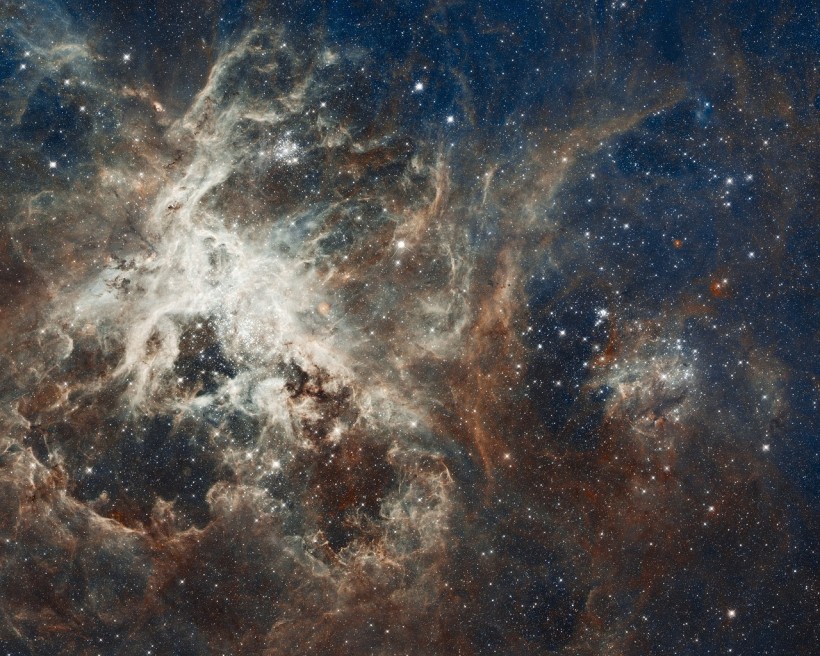Astronomer Adam Ginsburg and his team at the University of Florida, using the James Webb Space Telescope (JWST), recently unraveled mysteries surrounding "The Brick," a dense gas cloud at the Milky Way's core known for its opacity and has been a subject of scientific debate.
The JWST observations detailed in the paper, titled "JWST Reveals Widespread CO Ice and Gas Absorption in the Galactic Center Cloud G0.253+0.016" in The Astrophysical Journal, reveal an unusually high concentration of carbon monoxide (CO) ice that prompts a reassessment of established star formation theories in molecular clouds like The Brick.

JWST Explores 'The Brick' in the Milky Way, Unveiling Frozen Carbon Monoxide and Posing Challenges to Star Formation Theories
The Brick: A Paradoxical Region in Milky Way Rich in Frozen Carbon Monoxide
The Brick, located near the center of the Milky Way, presents a paradox by being both warm and icy, challenging existing star formation theories. Officially named G0.253+0.016, it is a dense, rectangular-shaped gas cloud within the Central Molecular Zone complex.
While stars typically form in cool regions where gas patches cool, clump, and trigger nuclear fusion, The Brick, with its abundant carbon monoxide ice, should be an ideal site for intense star birth. However, despite the prevalent ice, the gas in The Brick is unexpectedly warmer than anticipated.
This contradiction challenges established theories, suggesting that the mechanisms driving star formation in such regions are more complex than previously thought. Ginsburg emphasizes the importance of considering this newfound ice prevalence in future observations, underscoring its impact on our understanding of galactic star formation.
JWST's discovery of frozen carbon monoxide in The Bric surprises astronomers. It provides valuable insight into the interstellar medium at the galaxy's center, where the prevalence of this substance was previously unknown. This unexpected discovery prompts a reevaluation of the composition and conditions within nebulas at the Milky Way's core, opening up new avenues for exploring the complexities of star formation in these enigmatic regions.
READ ALSO: Building Blocks of Life Found Forming in the Star Formation Region of Perseus Molecular Cloud
Carbon Monoxide Ice in Galactic Center Reveals Surprising Gas-to-Dust Ratio
Recent observations are challenging previous assumptions about the abundance of carbon monoxide in the galactic center. The presence of carbon monoxide as icy particles reveals a lower gas-to-dust ratio than anticipated, a crucial metric for astronomers.
According to Ginsburg, JWST's capabilities allow for measurements of molecules in the solid phase, providing a more comprehensive understanding of their distribution and transportation. The team used the intense backlight from distant stars and hot gas to examine carbon monoxide ice distribution, surpassing previous limitations and analyzing over 10,000 stars in their study.
The next phase of research involves utilizing JWST to explore other ices present in The Brick and neighboring nebulas in the Galactic Center. This includes understanding the relative amounts of carbon monoxide, water, carbon dioxide, and complex molecules. The study aims to employ spectroscopy to trace the progression of chemistry over time in these molecular clouds.
Insights gained from studying the galactic center may have broader implications, offering a glimpse into star-forming conditions that mirror those in the early universe. The findings could also shed light on the formation of supermassive black holes and the composition of interstellar ice, providing clues about the molecules that make up our solar system.
For Ginsburg and the research team, these discoveries represent just a fraction of their observations of The Brick using JWST. Future efforts will involve a broader survey of interstellar ice between stars, contributing to a deeper understanding of the chemical evolution within these complex regions.
RELATED ARTICLE: Previously Unseen Star Formation in Milky Way Detected in New Study
Check out more news and information on Space in Science Times.




![Earth's Quasi-Moon Kamo‘oalewa Could Originate From Lunar Surface Not Asteroid Belt [Study]](https://1721181113.rsc.cdn77.org/data/thumbs/full/53275/89/56/50/40/earths-quasi-moon-kamo-oalewa-could-originate-from-lunar-surface-not-asteroid-belt-study.png)









